CUBA
General information, and practical advice
Money matters
Cuba has 2 different currencies, the MN (moneda nacional, or national currency), and the CUC (Pesos convertibles, or convertible pesos). Most tourists will only see and deal with the CUC, which is pegged at an artificial exchange rate of 1CUC= $0.86 USD. To avoid taking a 14% hit on every dollar you change, my advice is to bring Euros or Canadian Dollars, which have much more favorable exchange rates. For example, 1 Euro = CUC 1.27, so you are better off bringing currency other than the US Dollar. Wherever you exchange money (at the airport on arrival, at your hotel, or at exchange places called CADECA) the rates are all the same. Remember that Americans cannot use US credit cards or travelers cheques in Cuba, so bring enough cash to cover your expenses. Buy about $100-150 CUCs at a time, so you don't get stuck with a lot of CUCs at the end of your trip. When you buy CUCs, ask for small bills. You will be amazed how difficult it is to get change in certain places, so the smaller the denominations you carry with you, the better. Also keep coins with you, as many bathrooms expect a CUC0.25 'donation' as you leave.
Health Matters
The infrastructure in Cuba is in very poor condition, so be guided accordingly. Drink only mineral water, even to brush your teeth. Never drink from a tap. Buy Ciego Montero mineral water (from a local spring, either flat or sparkling), which is inexpensive, especially if purchased at markets and fast food shops/Pizza places in Havana. There are a number of confirmed cases of cholera in Cuba at this time, in various parts of the island, so my advice is to be safe and stay away from ice, fresh salads and unpeeled fruit for the duration of your stay. Bring sunscreen as the sun is very strong (Havana sits right below the Tropic of Cancer). During summer/fall when the rains start, bring insect repellent with you, as it is hard to find on the island. If you need a good pharmacy in Havana, the best one is the international pharmacy in the lobby level of the Hotel Habana LIbre (formerly the Havana Hilton, opened by Conrad Hilton himself in 1958!). In general, public bathrooms are in terrible shape, so it's wise to have tissue paper, handy wipes and hand disenfectant with you at all times, just in case you need it. Bring all medicines that you might need with you, as finding name brands or substitues in Cuba can be difficult.
Getting around Havana
The public transit system in Havana is woefully inadequate. Buses run infrequently and are always jam packed. You can easily get around by taxi (fares are usually 5CUC within Havana's cetral areas) or Coco-taxi, Cuba's version of Thailand's tuk-tuks, which are also 5CUCs and lots of fun. If you love old cars and want to splurge, you can ride in a vintage 1940s/1950s American car (usually Chevrolets, Oldsmobiles, Pontiacs) for about CUC10 per ride. Nothing beats a ride along the Malecon (the road that hugs the sea along Havana's Northern edge) in a 1950s convertible.
Safety
For the most part, Cuba is safe for travelers but it is best to be cautious as you would be in other parts of the Caribbean. Most hotels have in-room safes, which is highly recommended. Leave your good jewelry at home, not to tempt fate.
What to bring
First, a sense of humor and lots of patience. Cubans are friendly and outgoing, but service standards are below other parts of the world. Comfortable walking shoes are a must, especially in Old Havana, which has cobblestone streets and sidewalks in poor shape. Bring power bars, as these come in handy to tide you over between meals. FYI: it is hard to find options for vegetarians, so plan accordingly.
Internet
The better hotels in Havana usually have an internet center, where you buy minutes by the quarter hour. When using the internet, access will be restricted to certain news-oriented sites, but you will be able to pull up your email at Gmail, Yahoo, etc.
Newspapers
There are no newspapers for sale in Cuba other than Granma, the official newspaper of the Cuban government. Many hotels do have access to BBC or CNN, so you have some idea of what's going on in the world.
Arrival and departure advice
If you are traveling with a Cuban visa, make sure you keep your stamped copy, so you can surrender it at departure. On depature you must pay a 25CUC tax, which can ONLY be paid in CUC, so save some local currency for departure day. On departure, check in 3 hours prior to your flight's departure time, to be safe. Many of the charter flights to the US (used by the affinity groups like National Geographic, Insight, and other travel companies) run on an irregular schedule, so don't be surprised if you get to the airport and find your flight has been moved 1 hour earlier, as this happened to me yesterday.
Havana
Cuba's capital, has a population of about 2.5 million. Overall, the city is in a state of decay and disrepair, aside from a few renovated buildings and major tourist areas like parts of Old Havana (La Habana Vieja). The city is very spread out and you will need at least 3 days to see the major sights. Here are some ideas as to how best to organize your time, and places that are well worth visiting:
Old Havana
Havana was founded almost 500 years ago, so it makes sense to start in the oldest district where the city began. Start at the Plaza de la Catedral, where the city's beautiful baroque cathedral stands. The cathedral is open 1030a-3p daily, and there is no admission fee. The exterior is one of the finest examples of Cuban baroque architecture, and is in contrast to the interior, which is fairly simple. The square is surrounded by great colonial buildings such as the Casa del Marques de Arcos and the Casa de Lombillo. There is a museum of colonial art in the house of the Conde de Bayona, also facing the square. From here, it's a 5 minute walk to the Plaza de Armas, one of Havana's most beautiful squares. This is the spot where Havana was first founded, and the square witnessed many of Cuba's most important events. Visit the Castillo de la Real Fuerza, Havana's first major fort and now a naval museum that traces the history of ships and shipbuilding through the ages. Do not miss the views from the top staircase, to get a better sense of the fort (surrounded by a moat) and part of the old city. Facing the square is Havana's most beautiful colonial building, the Palacio de los Capitanes Generales, a masterpiece of 18th century architecture, which today houses the museum of Havana's history.
Hotel Ambos Mundos
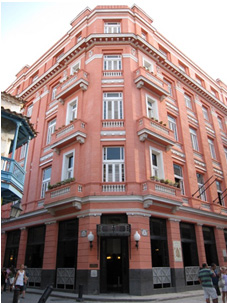
If you pick 1 museum to go to in old Havana, make this your choice. The building is open Tuesday to Sunday, and is well worth a visit. This building housed the governors of Cuba during the colonial years, and was the site of Cuba's first president's swearing in ceremony in 1902. From here, continue to the Plaza San Francisco, a beautiful square flanked by the church of San Francisco. From here, continue to the Plaza Vieja, a very different 16th century square flanked mostly by residential buildings. You can get lost in Old Havana's many narrow streets, each with its own history. If you are a fan of Ernest Hemingway, you can visit La Bodeguita del Medio, where Hemingway and many other celebrities used to while away the hours. The most interesting streets in Old Havana are Obrapia and Obispo running East-West, and Calle Oficios, running North-South. While in Old Havana, do not miss a stop at the Museo del Chocolate, to try their homemade hot chocolate or their famous candy ( calle Mercaderes corner Amargura st). Most visitors to Cuba visit old Havana, so expect to see troops of Americans, Canadians, and Europeans walking up and down the streets, as well as Cuban musicians playing live music on many corners. While in Old Havana, stop at the Hotel Ambos Mundos (Obispo street #153, corner of Mercaderes st), take the elevator to the roof, and have a drink/lunch in the rooftop bar with super views of Old Havana.
Centro Habana
This is the neighborhood next to old Havana, and well worth visiting. Much of the architecture is from the late 19th/early 20th century, when the former walls surrounding Havana were torn down to make room for the expanding city. Highlights: The Paseo del Prado is a great promenade flanked by trees and benches, running from the sea down towards the Parque Central/Capitol area. Regardless of your political views, the Museum of the Revolution is worth seeing, if only for the fact it is housed in the former Presidential Palace. If you visit, pay the extra 2CUC to visit the former offices and meeting rooms of Cuba's presidents, which are time capsules. Do miss the secret doorway used by Batista to escape revolutionaries who were trying to kill him in a palace coup in the late 50s. The most beautiful buildings in this area are the former Centro Gallego, now the Gran Teatro de La Habana, an enormous, block-size building with Beaux-arts architecture, and the Capitol. Havana's Capitolio is a smaller version of Washington's capitol, which unfortunately is not open for visits at the moment. If you are interested in architecture, visit the Bacardi Building (headquarters of the rum distiller) at the corner of San Juan de Dios and Villegas streets, near the Parque Central. This building is a masterpiece of Cuban Art Deco, and well worth seeing. Tip: Pay 1CUC at the reception desk, and visit the building's rooftop for a breathaking view of the city.
The Eastern Bay: Across the bay from Old Havana are two emblematic fortresses filled with history and well worth visiting, El Morro and La Cabana. Take a taxi to see them, and ask the driver to wait for you during your visit (there are no taxis waiting at the fortresses). El Morro is the older of the 2 fortresses, built in the 16th century to combat pirates and foreign armies trying to seize Havana. The lighthouse of El Morro is the symbol of the city has the best views of Havana, especially at sunset. Later on, the Spanish built the Fortaleza de la La Cabana further South, a massive 2,300 ft long fortress to secure the defense of the city. Note - the fortresses are enormous, and offer many walks and paths to explore. You can also visit various museums, chapels, and moats if you are interested in military history/construction. Even if you do not have much time, visiting the fortresses is a must.
Vedado and Beyond: This is a vast area, originally residential and now a mix of commercial buildings, apartment houses, stand-alone homes, and high rises. To get a sense of what Havana was like, walk along 23rd street from the river, or walk down Avenida de los Presidentes (G Street). A drive on the Malecon, the famous seawall that hugs the sea, is a must. You have probably seen The Plaza de la Revolucion on TV (this is where most political speeches and major events have taken place since 1959). If you visit, walk over to the Marti Monument, Havana's tallest landmark, to see fantastic views of the city from 350ft above Havana. ( Open Monday to Saturday).
Tourism in Havana is booming, and demand exceeds supply -- especially during peak season (November to April) when the weather tends to milder and there are no hurricanes. In general, service standards are far lower than in other places, so you need to be patient at all times, especially with the all-powerful reception staff. Rates are going up all the time, so the take the guidelines below, given to me, with a grain of salt. Tip: you must pay extra for a safety deposit box (usually 2CUC per day - but well worth it).
Santa Isabel
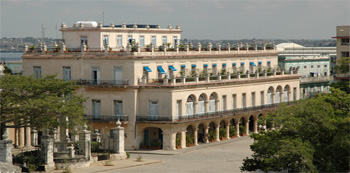
Old Havana
There are a number of options in this part of the city. The upside is that you walk out the front door and have many of the city's landmarks nearby. The downside is the noise, especially at night, and the wandering musicians and revelers coming out of bars and clubs that stay open late. hotel Ambos Mundos (Calle Obispo 153) is a good option, in the $100s. This is a clean, comfortable, simple hotel, well located. This is where Ernest Hemingway wrote 'For whom the bell tolls' years ago in room 511, which is kept exactly as he left it. At the top end, try the Hotel Santa Isabel which has hosted movie stars and presidents, starting in the $200s. Santa Isabel is located on the Plaza de Armas, so you cannot get more central than that. Tip - if you want this hotel, book way ahead as hotel only has 27 rooms. Their website is www.habaguanex.com
Centro Habana
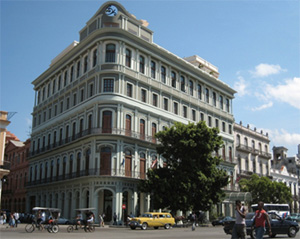
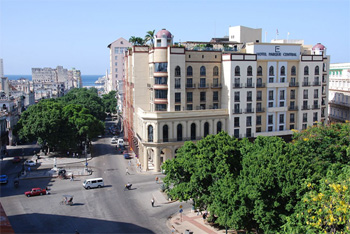
My 2 recommendations are The Parque Central, and the fairly new Saratoga. The Parque Central is run by Iberostar, is a good 3 star hotel. Note - the hotel has 2 wings, a 'classic' wing facing the Park, and the more modern wing, facing the side street. The 'classic' rooms are decorated in a nondescript, Ramada Inn 1970s decor - but - clean and efficient. the 'modern' wing is more streamlined and contemporary. If you have clients who are noise-averse, book rooms facing the interior courtyard (No view) which are very quiet. Both wings have rooftop pools, a welcome oasis after days of sightseeing in Havana. Food, service, staff, are all helpful and willing, if at times under a great deal of duress handling groups and big arrivals/departures.
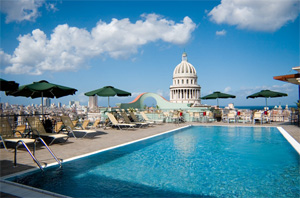
The Saratoga is the best hotel currently in Havana. Hotel opened in 2005 and faces the Capitol building and a large park. Hotel offers 96 bedrooms in various configurations, and all have very comfortable layouts, big modern bathrooms, and good service.
The hotel also has a super rooftop pool with breathtaking views of Havana in every direction. The hotel's main restaurant, Anacaona, is considered one of the top tables in the city. Rates here start in the $200s for single and $300s for double occupancy.
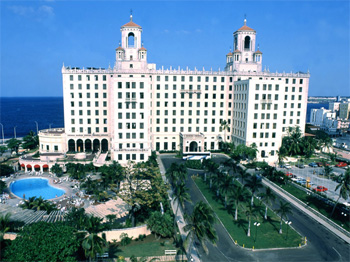
Vedado: The Most famous hotel in Cuba, by a mile, is the Hotel Nacional. The property goes back to 1930 and hosted presidents, Winston Churchill, Al Capone, movie stars, and celebrities of all sorts traveling through Havana over the last 80 years. As far as setting, nothing tops the Nacional. You arrive via a wonderful palm-studded avenue and walk into a grand, busy, noisy, lobby with high ceilings and lots of history. The hotel has 2 pools, vast gardens and terraces, and overlooks the Malecon and the El Morro fortress in the distance. Unfortunately -- the hotel is very tired and needs a major overhaul. The rooms, elevators, beds, hallways, are all in great need of a renovation. Service is spotty as the staff is overwhelmed with the zillions of people in the lobby (guests and " looky-loos " taking pictures) and the demands of groups from all over the globe, arriving hour after hour. Have a drink after dinner (live music is offered nightly on the terrace, which is charming) but -- stay elsewhere. You've been warned!
Beyond Vedado: The Hotel Melia Cohiba is a large, modern, block opened in 1995. Hotel is efficient, well run, but -- a soulless glass tower. My other objection is the location, furthest away from all the hotels mentioned up to this point. Most business people coming to Havana stay here.
Here are some photos, so you get an idea of the hotels.
Trip Write Ups
- Amalfi and Tuscany
- An American Safari
- Argentina: Latin Lovers and Tango!
- Costa Rica
- Cuba
- Dubai
- Egypt
- Graz - Austria
- Historic Quebec
- Holland at Tulip Time
- Japan
- Lake Como
- Lisbon
- Spellbound by Morocco
- Follow me North to Alaska
- A Passage to India
- Prague and Berlin
- Seabourn Odyssey ... Luxury Redefined
- South Africa
- Tahiti
- Vietnam, Laos & Bankok
- Nicaragua

